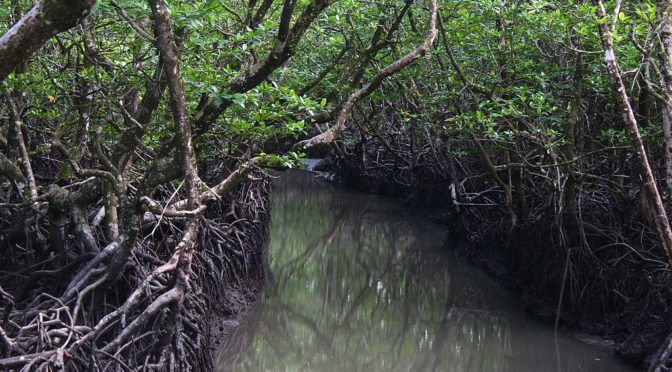Blue Carbon: the importance of salt marshes, mangrove forests and seagrass meadows as tools for battling climate change�
An Ecology Florida Feature
by Monica Starr
This article is the first of a three part series for October 2021
Monica Starr is an intern with Ecology Florida, serving as the Public Communications Facilitator for Ecology Florida News. Monica is a graduate student at the University of South Florida studying Global Sustainability.
Nutrient rich ecosystems including salt marshes, mangrove forests and seagrass beds are both productive, yet threatened by climate change all over the world. Not only do these ecosystems provide coastal protection, they work to capture carbon from both the water and the atmosphere.� Carbon sequestration prevents carbon dioxide from entering the Earth�s atmosphere. Because these complex ecosystems soak up the carbon that would otherwise trap heat in the atmosphere, trees and plants are essential players in efforts to mitigate climate change. We use the term �blue carbon� to describe the storage of carbon in places where land meets the sea (1). Over the past 50 years, we have seen these wetland habitats lose more than a third of their area (1). Coastal restoration efforts on a global scale is extremely important for both the health and biodiversity of species in these areas and for achieving climate mitigation and adaption goals.�
Looking more specifically at some of these buffering ecosystems, we can see various advantages for maintaining and protecting salt marshes, seagrass beds and mangroves. Some of these blue carbon ecosystems can also absorb excess carbon dioxide from surrounding water which can reduce the intensity of ocean acidification. Ocean acidification can pose a threat to marine life as we have seen this last summer in Tampa during the Red Tide event. Also, coastal ecosystems provide food and shelter for thousands of marine species. Providing food and refuge for fish and other marine invertebrates can drive global fisheries and offer food sovereignty to coastal, indigenous groups globally.�
Salt marshes provide food, refuge and habitat for over 75% of U.S. fisheries species like shrimp and crabs while sequestering nearly 1,900 pounds of carbon per acre, per year (2). By reducing the release of pollutants into these coastal waterways, taxpayers end up saving millions of dollars worldwide (3). In Galveston Bay, Texas there is an estimated savings of $124 million through reduced demand on municipal wastewater treatment (3). Seagrass beds provide a nursery and feeding ground for 20% of the largest fisheries including cod, pollock and herring (4). These seagrass beds can sequester nearly 1,200 pounds of carbon per acre, per year (5) and they store around 10% of all organic carbon sequestered in the ocean annually (6).� Finally, mangroves protect coastal areas from storms, protecting nearly 200 million people worldwide and it is estimated that mangroves can provide $65 billion annually in global flood protection benefits (7).�
On a global scale, restoration efforts are becoming more and more recognized. Protecting and restoring these important coastal habitats is extremely important moving forward. Collective policy action from an international, national and state level can allow us to harness the power of these blue carbon ecosystems in order to address climate change. Both the ecological and economic benefits are already being seen on a global scale and we must continue to recognize the importance of maintaining these essential ecosystems.�
Resources
- Coastal ‘Blue Carbon’: An Important Tool for Combating Climate Change | The Pew Charitable Trusts. (2021).��
- E. McLeod et al., �A Blueprint for Blue Carbon: Toward an Improved Understanding of the Role of Vegetated Coastal Habitats in Sequestering CO2,��Frontiers in Ecology and the Environment�9, no. 10 (2011): 552-60,�https://doi.org/10.1890/110004.
- J. Ko, �The Economic Value of Ecosystem Services Provided by the Galveston Bay/Estuary System� (Geotechnology Research Institute, 2007).
- R.K.F. Unsworth, L.M. Nordlund, and L.C. Cullen-Unsworth, �Seagrass Meadows Support Global Fisheries Production,��Conservation Letters�12, no. 1 (2019): e12566,�https://doi.org/10.1111/conl.12566.
- E. McLeod et al., �A Blueprint for Blue Carbon.�
- Ibid.; J.W. Fourqurean et al., �Seagrass Ecosystems as a Globally Significant Carbon Stock,��Nature Geoscience�5, no. 7 (2012): 505-09,�https://doi.org/10.1038/ngeo1477.
- M.D. Spalding, R.D. Brumbaugh, and E. Landis, �Atlas of Ocean Wealth� (The Nature Conservancy, (2016).�


Leave a Reply